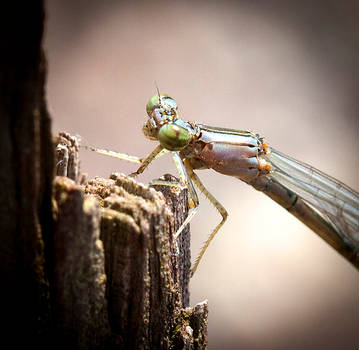ShopDreamUp AI ArtDreamUp
Deviation Actions
Description
Taken at night in Singapore forest.
Quote from en.wikipedia.org/wiki/Dragonfl…
Dragonflies are hemimetabolous insects; they do not have a pupal stage and undergo an incomplete metamorphosis with a series of nymphal stages from which the adult emerges.[39] Eggs laid inside plant tissues are usually shaped like grains of rice, while other eggs are the size of a pinhead, ellipsoidal, or nearly spherical. A clutch may have as many as 1500 eggs, and they take about a week to hatch into aquatic nymphs or naiads which moult between six and 15 times (depending on species) as they grow.[7] Most of a dragonfly's life is spent as a nymph, beneath the water's surface. The nymph extends its labium (a toothed mouthpart) to catch animals such as mosquito larvae, tadpoles, and small fish.[39] They breathe through gills in their rectum, and can rapidly propel themselves by suddenly expelling water through the anus.[40] Some naiads, such as the later stages of Antipodophlebia asthenes, hunt on land.[41]
The larval stage of large dragonflies lasts up to five years in large species, and between two months and three years in smaller species. When the naiad is ready to metamorphose into an adult, it stops feeding and makes its way to the surface, generally at night. It remains stationary with its head out of the water, while its respiration system adapts to breathing air, then climbs up a reed or other emergent plant, and moults (ecdysis). Anchoring itself firmly in a vertical position with its claws, its skin begins to split at a weak spot behind the head. The adult dragonfly crawls out of its larval skin, the exuvia, arching backwards when all but the tip of its abdomen is free, to allow its exoskeleton to harden. Curling back upwards, it completes its emergence, swallowing air, which plumps out its body, and pumping haemolymph into its wings, which causes them to expand to their full extent.[42]
Dragonflies in temperate areas can be categorized into two groups, an early group and a later one. In any one area, individuals of a particular "spring species" emerge within a few days of each other. The springtime darner (Basiaeschna janata), for example, is suddenly very common in the spring, but has disappeared a few weeks later and is not seen again until the following year. By contrast, a "summer species" emerges over a period of weeks or months, later in the year. They may be seen on the wing for several months, but this may represent a whole series of individuals, with new adults hatching out as earlier ones complete their short lifespans.[43]
Quote from en.wikipedia.org/wiki/Dragonfl…
Dragonflies are hemimetabolous insects; they do not have a pupal stage and undergo an incomplete metamorphosis with a series of nymphal stages from which the adult emerges.[39] Eggs laid inside plant tissues are usually shaped like grains of rice, while other eggs are the size of a pinhead, ellipsoidal, or nearly spherical. A clutch may have as many as 1500 eggs, and they take about a week to hatch into aquatic nymphs or naiads which moult between six and 15 times (depending on species) as they grow.[7] Most of a dragonfly's life is spent as a nymph, beneath the water's surface. The nymph extends its labium (a toothed mouthpart) to catch animals such as mosquito larvae, tadpoles, and small fish.[39] They breathe through gills in their rectum, and can rapidly propel themselves by suddenly expelling water through the anus.[40] Some naiads, such as the later stages of Antipodophlebia asthenes, hunt on land.[41]
The larval stage of large dragonflies lasts up to five years in large species, and between two months and three years in smaller species. When the naiad is ready to metamorphose into an adult, it stops feeding and makes its way to the surface, generally at night. It remains stationary with its head out of the water, while its respiration system adapts to breathing air, then climbs up a reed or other emergent plant, and moults (ecdysis). Anchoring itself firmly in a vertical position with its claws, its skin begins to split at a weak spot behind the head. The adult dragonfly crawls out of its larval skin, the exuvia, arching backwards when all but the tip of its abdomen is free, to allow its exoskeleton to harden. Curling back upwards, it completes its emergence, swallowing air, which plumps out its body, and pumping haemolymph into its wings, which causes them to expand to their full extent.[42]
Dragonflies in temperate areas can be categorized into two groups, an early group and a later one. In any one area, individuals of a particular "spring species" emerge within a few days of each other. The springtime darner (Basiaeschna janata), for example, is suddenly very common in the spring, but has disappeared a few weeks later and is not seen again until the following year. By contrast, a "summer species" emerges over a period of weeks or months, later in the year. They may be seen on the wing for several months, but this may represent a whole series of individuals, with new adults hatching out as earlier ones complete their short lifespans.[43]
Image size
1067x1600px 585.38 KB
Make
Canon
Model
Canon EOS 5D Mark II
Shutter Speed
1/160 second
Aperture
F/16.0
Focal Length
100 mm
ISO Speed
100
Date Taken
Feb 10, 2016, 2:07:09 AM
Sensor Size
7mm
© 2016 - 2024 melvynyeo
Comments2
Join the community to add your comment. Already a deviant? Log In
Fantastic !



































